Pattern Crafting: a vest in biker style
Auch ohne Motorrad gefallen mir Biker Jacken wegen ihrer klaren Schnittform gut. Man kann sie zwar im Moment auch überall kaufen, aber natürlich passt das dann nicht so gut. Also selber machen. Und da es mühsamer ist, einen Schnitt anzupassen, als einen passenden Schnitt umzubasteln, war mal wieder Bastelzeit. 🙂
I don’t have a motor bike, but vests in biker style I like for the clear and pure shape. You can buy them easily at the moment, but RTW never really fits me. So time for DIY. And since it is more tedious to fit a new pattern than changing a already fitted pattern it was time for pattern crafting.
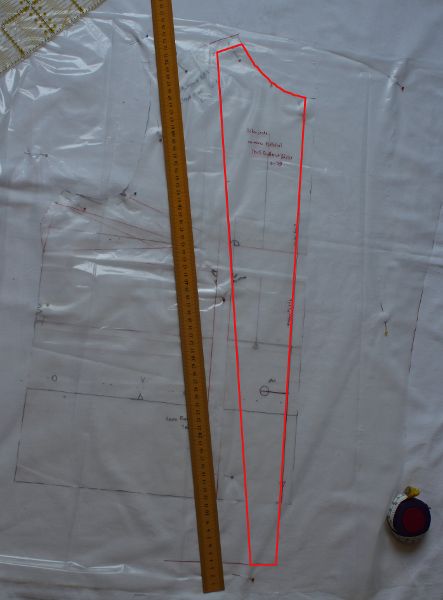 Ausgangspunkt war eine kurze relativ gerade Jacke mit einem Brustabnäher vorne. Butterick 5927 wie hier schon mal verwendet. Ich brauche jetzt ein zweiteiliges Vorderteil, das in der Mitte überlappt und eine schräge Teilungsnaht hat. Wegen der Schräge muß man vorher wissen, wie lange die Jacke werden soll und wie breit die Überlappung ist. Die Bilder zeigen meine zweite Variante, mit angepaßter Länge nach dem ersten Probeteil… Ich habe meinen Vorderteilschnitt auf der Unterlage festgesteckt und dann ein Stück Folie darüber gesteckt. Ich ziehe eine schräge Linie vom Saum, etwa 5 cm links der Mitte zur Schulter, etwa zwei Fingerbreit neben demHalsausschnitt. Den Rest von Halsausschnitt und vordere Mitte pause ich von dem Ursprungsschnitt ab.
Ausgangspunkt war eine kurze relativ gerade Jacke mit einem Brustabnäher vorne. Butterick 5927 wie hier schon mal verwendet. Ich brauche jetzt ein zweiteiliges Vorderteil, das in der Mitte überlappt und eine schräge Teilungsnaht hat. Wegen der Schräge muß man vorher wissen, wie lange die Jacke werden soll und wie breit die Überlappung ist. Die Bilder zeigen meine zweite Variante, mit angepaßter Länge nach dem ersten Probeteil… Ich habe meinen Vorderteilschnitt auf der Unterlage festgesteckt und dann ein Stück Folie darüber gesteckt. Ich ziehe eine schräge Linie vom Saum, etwa 5 cm links der Mitte zur Schulter, etwa zwei Fingerbreit neben demHalsausschnitt. Den Rest von Halsausschnitt und vordere Mitte pause ich von dem Ursprungsschnitt ab.
My starting point is a relatively straight and short Jacket with a vreast dart. Butterick 5927 as already used here. Now I need a two piece front which overlaps in the middle and has a diagonal seam. Because of the straight diagnoal line you need to know beforehand how long the vest is supposed to be. So the pics show the second version after the first muslin… I pinned my front pattern to my working space (on a folded bed sheet). Then I pinned a new plastic sheet over it. Now I am drawing a diagonal line from the hem to the shouider. I started about 5 cm left from the middle on the bottom and arrived about two fingers wide next to the neckline. For the rest, the neckline and the front middle I copy the lines of the original pattern.
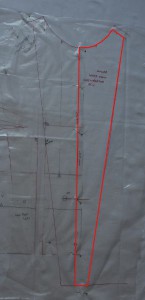
Das mittlere Vorderteil muß gedoppelt werden, also falte ich meine Folie entlang der vorderen Mittellinie und kopiere das im vorherigen Schritt entstandene Vorderteil. Jetzt noch beschriften….
The middle front needs to be mirrored. So I am folding the plastic sheet along the front middle and I am tracing the line I made in the last step. Not forgetting to lable the pattern….
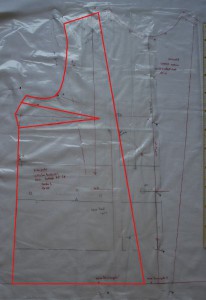
Für das seitliche Vorderteil kommt eine dritte Schicht Folie drüber und ich kopiere von meiner schrägen Teilungnaht zur Seite hin. Auch hier nicht vergessen, Paßzeichen mit zu übertragen und das Teil gut zu beschriften.
For the side front piece I add a third clear plastic sheet over the other two and I trace from the newly drawn diagonal seam to the side. Not forgetting to trace marks and notches and labeling everything.
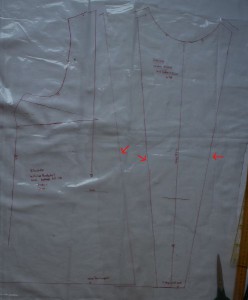
So sehen dann die beiden neuen Vorderteile aus. Da der Butterickschnitt schon Nahtzugaben hat, meine neu gezeichneten Nahtlinien aber nicht, muß ich da natürlich noch die Nahtzgabe ergänzen.
That are my new front patterns. The Butterick Pattern has seam allowances included, my newly made seam seam hasn’t. So I need to add seam allowances there.
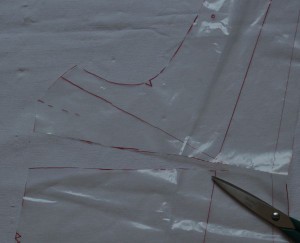
Jetzt soll noch der Abnäher raus. Ich schneide entlang einer Abnäherline gerade bis zur Teilungsnaht durch.
Now I want to remove the bust dart. Cutting one of the dart seam lines straight to my new seam.
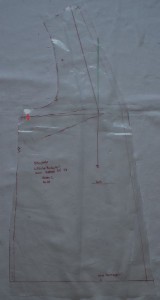
Und jetzt den zweiten Abnäherschenkel auf den durchgeschnittenen falten. Da ich nicht bis zur Abnäherspitze, sondern weiter bis zur Teilungsnaht geschnitten habe können die Linien nicht genau zur Deckung gebracht werden. Wichtig ist, daß sie genau auf der seitlichen Nahtlinine genau aufeinander liegen. Denn sonst stimmt die Länge der Seitennaht nicht mehr. (Je nach Figur bzw. Abnähertiefe ist es möglich, daß das Vorderteil dann nicht mehr passt. Bei mir haut es hin, das hatte ich am ersten Probeteil schon getestet…) Danach muß man die Nahtzugabe noch einschneiden und ergänzen, damit sie sich der Rundung anpasst.
Now I am folding the second dart seam over the one I’ve cut open. Since I did not cut further than the dart I can’t align the two lines. So it is important to match them exactely on the side seam. If not the side seams of front and back will not match. (Depending on your individual figure and the depth of the dart it might be, that the front does not fit any longer after that operation. For me it works, my first muslin had proven that…) And the last step is to snip in the seam allowance and taping a bit of plastic sheet unterneath (or just two pieces of adhesive tape, one from each side) to adapt the seam allowance to the now curved shape.
Und schon habe ich meine Biker Jacke. (Nach dem nächsten Probeteil habe ich das Vorderteil in der Ausschnittline noch mal etwas geändert. Die Änderung ging dann aber ohne weiteren Test.)
And the pattern for a biker style vest is finished. (After the second muslin I decided to change the neckline of the front middle a bit. But that was a minor adjustment and did not need another test.)
